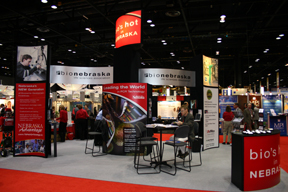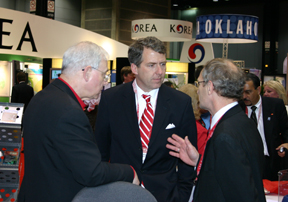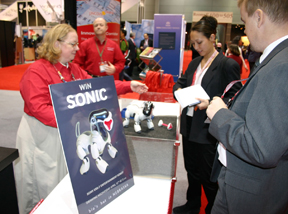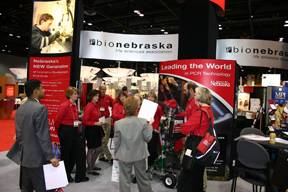 |
The Nebraska pavilion at the BIO 2006 conference in Chicago. Photos by Joel Brehm of UNL. |
But that wasn’t Nebraska’s exhibit at the world’s largest biotechnology convention inside Chicago’s McCormick Place Convention Center.
Instead, Nebraska’s high-tech pavilion caught the attention of thousands of biotechnology executives, investors, journalists, policymakers and scientists, with its life-sized talking robot, Sprockit; its computerized dog, Sonic; and a team of Nebraskans dressed in red “Bio’s Hot in Nebraska” shirts.
The Nebraska delegation was among about 20,000 people — including 1,700 companies, organizations and institutions — representing the biotechnology industry at the Biotechnology Industry Organization’s April 9-12 biotechnology convention, known as “BIO 2006.” The goal was to showcase biotechnology inventions, developing inventions, and opportunities for companies to establish biotechnology businesses in Nebraska.
Nebraska’s involvement in the international convention began in 1999 without a booth and only three representatives from UNMC. Today, it involves 25 representatives from across the state with a colorful, multi-panel 16-foot-tall exhibit taking up nearly 600 square feet. The exhibit featured photos, digital video screens and information racks, and a rotating lighted panel proclaiming: “Bio’s Hot in Nebraska.”
 |
University of Nebraska President J.B. Milliken, center, talks with Don Leuenberger, left, UNMC vice chancellor for business and finance, and Darrell Ullman, Technology Manager, Department of Economic Development, State of Nebraska. |
This was the second year for a statewide presence, said Don Leuenberger, vice chancellor for business and finance at UNMC. In addition, the Bio Nebraska Life Sciences Association was created last year as a focal point in generating economic development for the state and creating quality jobs and opportunities.
Like others at the booth, Tom McDonald, Ph.D., president and CEO, UNeMed Corp., UNMC’s technology transfer company, had a steady stream of potential customers and curious people asking about developing and developed technology. He was one of three people from UNMC to attend the BIO convention in 1999 to find out what it was all about.
“We just went,” Dr. McDonald said. “We didn’t have a booth, but realized the positive impact this conference had on economic development and decided Omaha and Nebraska needed to be a participant at this annual event.” Dr. McDonald said. Leuenberger and Rod Moseman of the Greater Omaha Chamber of Commerce reserved booth space for Nebraska’s presence at the 2000 conference.
 |
Sonic, the computerized dog, was an attention-getter at the Nebraska pavilion. Here, Liz Kumru registers two convention goers a chance to win the dog. The acual winner was Robert Borgman of Elk Grove Village, Ill. Borgman is a graduate of Creighton University. |
Sonic, the computerized Sony dog, also attracted audiences and curious stares with its tail-wagging, occasional whining and bone-fetching capabilities. Its “puppy-dog eyes” cuteness elicited petting from many. Some even spoke to the dog. Sonic was the prize giveaway that encouraged people to stop by and register at the Nebraska pavilion.
The robotic entertainment didn’t overshadow the real Nebraskans at the pavilions, who attracted visitors with their warmth and friendliness. “We had people say, ‘You guys are so friendly, you look so good,’ ” Dr. McDonald said. “What made the Nebraska booth attractive is attitude, openness, friendliness and interactiveness. People are attracted to that sort of thing.”
It was fitting that mini-robots was one of the new technologies Nebraska featured this year. Surgeons at UNMC and engineers at the University of Nebraska-Lincoln are testing miniature robots that would be placed in the abdomen to assist surgeons during surgery. The remotely controlled in vivo robots provide the surgeon with an enhanced field of view from arbitrary angles as well as provide dexterous manipulators not constrained by small incisions in the abdominal wall.
 |
The Nebraska team organizes one morning before the convention kicks off. |
Drs. Oleynikov, Platt and Shane Farritor, Ph.D., associate professor in the Department of Mechanical Engineering, are part of a team that designed the robots.
Marsha Morien, UNMC administrator for advanced biomedical technologies, who has spearheaded the BIO group from its early days, said it’s important for UNMC and Nebraska to be involved in BIO. “The biotechnology presence in Nebraska is growing,” she said. “It’s helped to have our presence at the show. We’ve made contacts with those we can work with as partners. We’ve developed relationships. We’re also building awareness about what Nebraska has to offer.”
Dr. McDonald said many business relationships begin at BIO.
Some of those relationships have resulted in three different resources of capital for investing in start-up companies. TriMed Research Inc., will soon receive $5 million euros (about $6.17 million). A deal was sealed recently with a California company that will provide a $1.5 million research grant for joint development of technology. In addition, a number of technologies have been licensed.
“It wouldn’t have happened if we weren’t here,” Dr. McDonald said. “We meet a lot of industry marketing consultants and venture capitalists looking for opportunities. The list is endless. Potential investors have told me that our presence at BIO means a lot to them. It shows the industry we’re serious.”